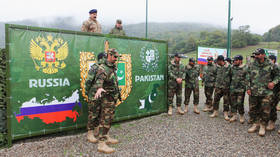Read COLREGs, lol.check the wake of the Russian warship
clearly made the move against the USN
You are using an out of date browser. It may not display this or other websites correctly.
You should upgrade or use an alternative browser.
You should upgrade or use an alternative browser.
Russian Military News, Reports, Data, etc.
- Thread starter tphuang
- Start date
I have to give you credit for making an attempt to posit a view where you don't have underlying evidence to support your case.
Sometimes the evidence simply isn't public and you have to make a judgement call based on circumstantial clues - as the saying goes, absence of evidence is not necessarily evidence of absence.
I am sure Russia has the intention to incorporate some sort of CEC capability into its S400 kill chain. It is most logical given the limited LOS due to the earth's curvature against low flying threats using terrain masking. Having the intention and building the necessary capability is a long road ahead.
Considering the lack of substantial missile airframe changes in combination with the prolonged development period, it stands to reason that it could well be more than a mere intention by now. Again, if it wasn't the novel guidance system (one that you might surmise addresses the LOS issues inherent with the intended range capability in some way), what was it that kept 40N6 from entering service for so long?
The A-100 look down capability will address the main weakness associated with the present weakness.
The A-50 had/has satisfactory look-down capability (especially over water, where it was sometimes reported to be better than the contemporary E-3) - you may be thinking about the preceding Tu-126 (which was problematic in this, and several other, respects).
Btw, any idea what is happening with the A-100 program? I have a book on the A-50 but yet to read up on its capabilities.
A test bed based on an A-50 first flew in 2017, sans the radar, and a fully equipped prototype (including radar and PS-90A engines) entered testing last year.
There isn't much in the public domain about its capabilities, other than that is has an AESA radar but in a rotodome (as opposed to the triangular array adopted by Phalcon/KJ2000). Against typical sea and high altitude air targets, the detection ranges quoted for it are equivalent to the radar horizon at the normal patrol altitude for the Il-76 platform, but that is to be expected for such a large, powerful radar. Going by the extensive antenna farm visible on the outside, it appears to be lavishly equipped in the ESM and comms department, but that too is not much of a surprise if you contrast the A-50 and early E-3 versions (before the ESM upgrade, and its JTIDS datalink was largely orphaned on the fighter side until long after the Cold War ended).
My biggest criticism is that, one way or another, the mission system is hosted on the wrong airframe platform. If it's truly too heavy for the *much* more efficient Tu-214, the Il-96 would have offered significantly better endurance and greater crew comfort at approximately the same cost. For reference, the mission system on the A-50 came in at some 20t, if we assume the A-100 suite is similar in weight the Il-96T has a whopping 50% range/endurance advantage over the re-engined Il-76 (with the same engines!) at this payload. That's without auxiliary fuel tanks in the underfloor cargo hold which would be feasible if the cargo variant's 270t MTOW was adopted. If the mission system is lighter than 20t by as little as 15%, the Tu-214 would return endurance matching or exceeding the Wedgetail (and not far off the performance of the A-50 & E-3) while providing a *major* operating cost advantage. In fact, there have been reports that a port to the Tu-214 is being seriously considered... if true they should use the Il-76-based version as a mission system demonstrator only and switch mass production to the Tupolev platform.
Last edited:
It will never happen, not in the foreseeble future at least.If they keep delaying it, they might be able to put it on the CRAIC 929.
Such a usage requires in-house design. And 929 is literally full of western bells and whistles.
It will never happen, not in the foreseeble future at least.
Such a usage requires in-house design. And 929 is literally full of western bells and whistles.
Will it be so? Russia is already designing the PD-35 engine. PD-14 design is basically finished and all it needs is certification and production.
The funding went in early 2018 and the PD-35 engine is supposed to be tested by 2023. i.e. they expect to take the typical 5 year period to develop it.
Most of the new technologies in the project involve CMC which is something China has good knowledge base in case Russia has issues.
Most of the other systems in terms of avionics will be similar to those in the 919 or the MC-21. That leaves the manufacturing of large parts.
But that is basically a matter of scaling up what they are already doing.
Still, I was half joking. By the time it probably will enter large production, in like 2024 or 2025, even the A-100 should be in service.
Jura The idiot
General
TASS upolnomochen zayavit ... to begin her sea trials in 2021 after the refurbishing (didn't notice any details except "the work is currently on schedule"); dated June 6 of this year:
Основные ремонтные работы на "Адмирале Кузнецове" завершат в 2020 году
Основные ремонтные работы на "Адмирале Кузнецове" завершат в 2020 году






